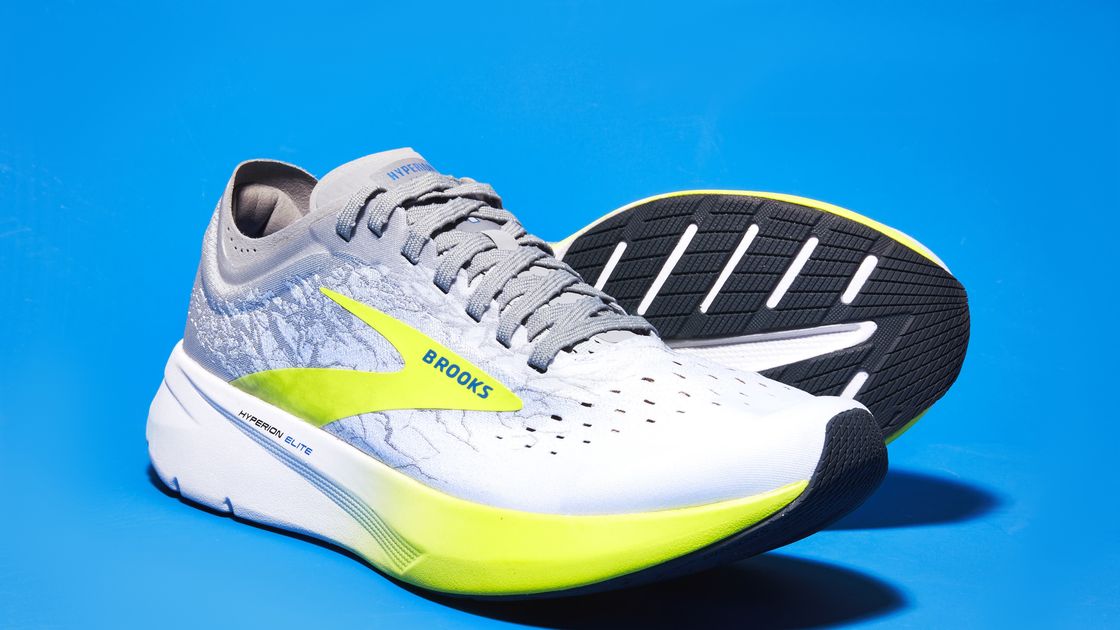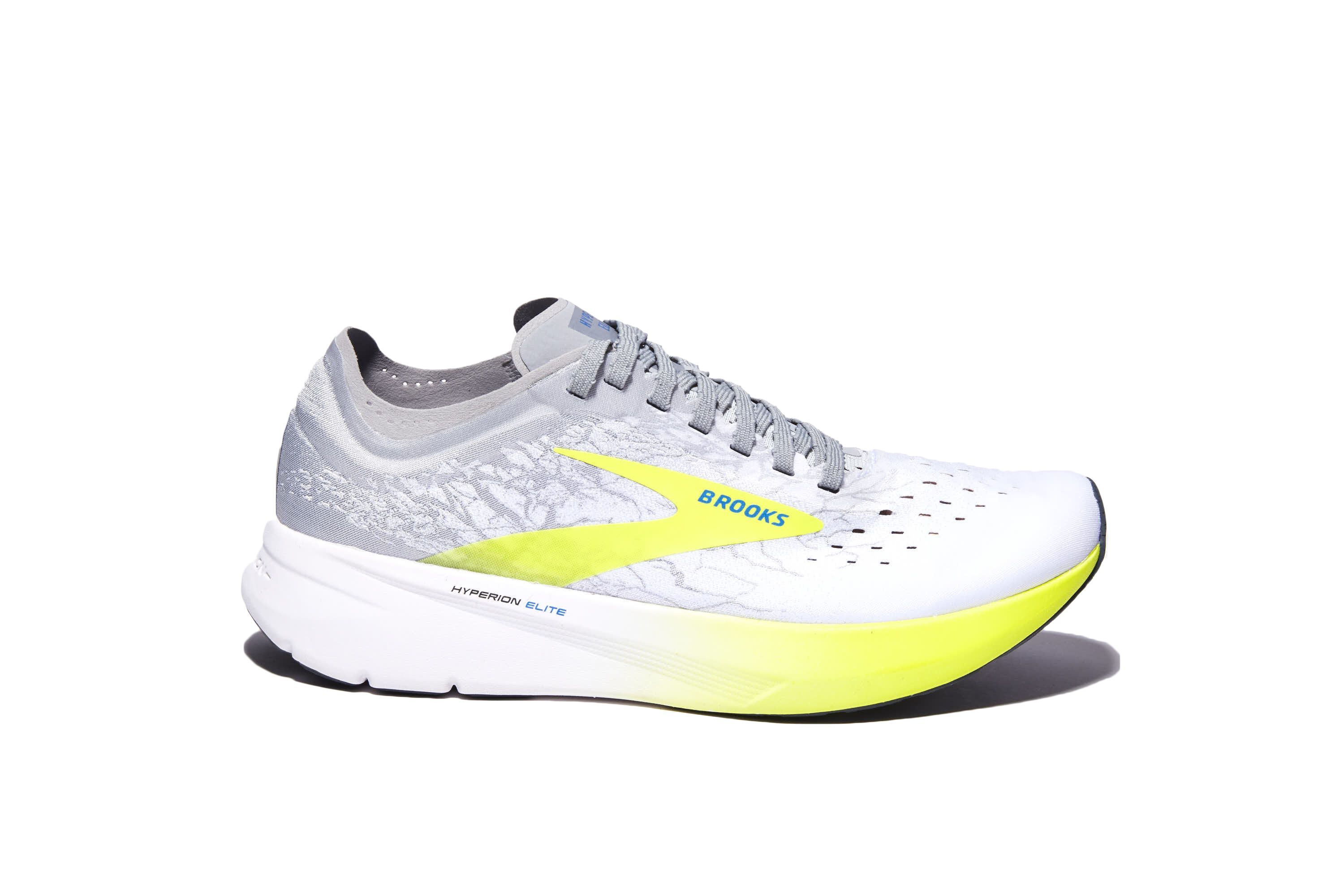The RW Takeaway: As thick shoes with a carbon-fiber plate skirted a ban, Brooks is releasing the Hyperion Elite, a lightweight and fast shoe made for breaking finish line tape.
- New DNA Zero foam midsole is 45 percent lighter than BioMoGo DNA
- Carbon-fiber plate sandwiched in the midsole foam promotes propulsion
- Feather-light, minimal upper
Price: $250
Type: Road, Racing
Drop: 8mm
Weight: 7.0 oz (M), 5.4 oz (W, unisex, men’s size 5.5)
Available: February 29
It’s been a long time coming, and shrouded in mystery—as well as literally cloaked in black paint at the 2018 Boston Marathon—but Brooks has finally revealed the Hyperion Elite, the prized racing shoe that could be a Vaporfly contender. Here’s a first look at Brooks’s tour de force and how it races.
Backstory
Replay Desiree Linden’s historic first place finish in Boston two years ago and try not to be moved when she crosses the finish line; replay it again and again, and try, just try, to make out the running shoes that helped her nail that win. (Shadrack Biwott, who also wore a pair, claimed third overall and was the first American finisher.) We now know that those shoes were prototypes of the Hyperion Elite, which will finally be made available to the rest of us on Leap Day, coinciding with the Olympic Marathon Trials.
Project Hyperion Elite began August 2017, and was heavily safeguarded as the shoe underwent multiple rounds of testing. Dathan Ritzenhein wore an earlier version of the Elite at the 2018 New York City Half Marathon, where he came in second place. Linden’s shoes, which were hand delivered to her only four days before the marathon (Biwott said he received his the “Wednesday before Boston”), were painted black before the race. There was some speculation on running message boards and social media that Brooks runners were wearing blacked-out Vaporflys, when keen observers spotted white outsoles as the black paint peeled away. Hold the Elite in your hands, however, and you’ll realize just how dissimilar the Elite is from the Swoosh—as well as how completely different it feels sprinting down the road.
DNA Zero
This past December at The Running Event in Austin, Texas, I sat down with Brooks’s Blue Line senior manager Nikhil Jain, to learn the intricate details of the Hyperion Elite.
The first thing to take into account is that the shoe was formed using a new last, resulting in more room in the forefoot so that your toes can splay for leverage. The upper is feather-light, 25 percent nylon, water-resistant, and has a minimal collar. The outsole is Brooks’s thinnest yet at 2mm thick.
The Elite’s look is inspired by the burning tail of a comet, what Jain called its “crackle effect.” The white/gray/yellow version will have a more subtle presence compared to the conspicuous lime green and hot pink we’re now used to seeing at races.
At its core is a full-length DNA Zero midsole, which Jain said is 45 percent lighter than the brand’s proprietary BioMoGo DNA foam. Sandwiched between two layers of DNA Zero is the carbon-fiber plate. Like the plate in Nike’s shoes and the Hoka One One Carbon X, it gives you a snappy toe-off as you’re racing at high speeds.
Because the focus for the Hyperion Elite is for it to be as light as possible, durability was not a concern. Brooks expects the shoe to last just 50 to 100 miles.
Racing in the Hyperion Elite
I became addicted to the Vaporfly 4%’s propulsive bounce after they were handed to me for testing in fall 2018. But, because I love Brooks’s training shoes, I had to see if the Hyperion Elite would deliver the same speed. The best way to test out Brooks’s secret shoe: Wear it in the Philadelphia Marathon—I signed up just two weeks before race day.
Because I know you shouldn’t try anything new toeing the starting line, I gave the shoes a test run around my 6-mile office loop. Of the over 115 times I’ve run that loop testing shoes, my fastest split was when I tested the Hyperion Elite.
The Elite has that familiar Brooks fit and feel; instead of my foot feeling slightly compressed like it does in the Vaporfly (Nikes for me typically run narrow), there’s that ample room I’m used to when I put on a Brooks shoe. Because the Elites are unisex (women should go down 1.5 sizes), the fit around the ankle is a little wide, and feels less secure because of the minimal heel collar. The cushioning is firm, and reminds me of the PureProject line without the foot pods on the outsole, which you could sometimes feel underfoot.
At the Philadelphia Marathon, I’m not exaggerating when I say I practically tackled the pavement for 75 percent of the race, in spite of little training, a heavy Philly cheesesteak dinner, and lack of sleep. My legs and feet were bewitched; I felt like I was flying. The shoes may not have that Vaporfly bounce, but they didn’t destroy my pinky toes, nor make my feet overheat (the 4%’s Flyknit upper has a sock-like—at times, suffocating—fit with a narrow toe box). That impressive rebound promoted by the carbon plate and DNA Zero in the midsole helped me maintain a fast clip for most of the race. I was only seconds shy of a new PR, which I had earned months before wearing the 4% at Boston—and with a proper training build-up.
In my meeting with Jain, he noted how stability with propulsion was an important biomechanical footnote in creating the Elite. Jain and his team noticed how competitors’ racers caused ankle-rolling, an issue that can worsen later in a race due to fatigue. When I run in the Vaporfly 4%, I have to make sure I wear quarter-length socks so I won’t massacre the skin on my ankles from kicking due to late-onset overpronation. This isn’t the case with the Hyperion Elite.
Since the Philly Marathon, my pair of Vaporflys have been untouched and stashed away in my hall closet. But not everyone will find the Elite their cup of tea.
“It’s really freaking hard!” said runner-in-chief Jeff Dengate. “That foam is exceptionally lightweight but incredibly stiff. It’s definitely not like the cushy, bouncy ride you get from a Vaporfly 4%. I personally don’t think I could go a full marathon in them, as a 155-pound guy.” Dengate was a fan of the upper, however, stating the lightweight woven material felt “supremely soft” and secure.
The Elite doesn’t guarantee you’ll run 4 percent (or more) faster, like Nike’s trainers. However, its short history shows it has the chops to potentially step onto that podium in Atlanta. We’ll have to wait and see how Hyperion Elite-wearing Olympics hopefuls fare on February 29.
Amanda is a test editor at Runner’s World who has run the Boston Marathon every year since 2013; she's a former professional baker with a master’s in gastronomy and she carb-loads on snickerdoodles.


















